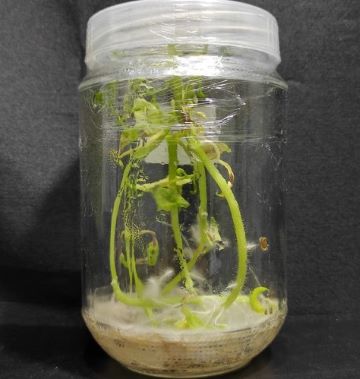
Drought tolerance selection of several tomato varieties by using polyethylene glycol
Sholeh Avivi(1*), Novrida Yanti Sitompul(2), Tri Agus Siswoyo(3), Mohammad Ubaidillah(4)
(1) University of Jember
(2) University of Jember
(3) University of Jember
(4) University of Jember
(*) Corresponding Author
Abstract
Keywords
Full Text:
PDFReferences
Alordzinu, K.E., Li, J., Lan, Y., Appiah, S.A., Aasmi, A., and Wang, H. (2021). Rapid estimation of crop water stress index on tomato growth. Sensors, 21(15), 5142.
Chandrasekaran, M., Boopathi, T., and Manivannan, P. (2021). Comprehensive assessment of ameliorative effects of amf in alleviating abiotic stress in tomato plants. Journal of Fungi, 7(4), 303.
Cui, Q., Li, Y., He, X., Li, S., Zhong, X., Liu, B., Zhang, D., and Li, Q. (2019). Physiological and iTRAQ based proteomics analyses reveal the mechanism of elevated CO₂ concentration alleviating drought stress in cucumber (Cucumis sativus L.) seedlings. Plant Physiology and Biochemistry, 143(July), pp. 142–153.
Dwinanti, A. W. and Damanhuri. (2021). Uji Daya Hasil Calon Varietas Hibrida Tomat (Lycopersicum esculentum Mill.) pada Musim Hujan. PLANTROPICA: Journal of Agricultural Science, 6(1), pp. 38–48.
Esan, V. I., Ayanbamiji, T. A., Adeyemo, J. O., and Oluwafemi, S. (2018). Effect of Drought on Seed Germination and Early Seedling of Tomato Genotypes using Polyethylene Glycol 6000. International Journal of Sciences, 4(02), pp. 36–43.
Estiningtyas, W., Boer. R., Las, I., and Buono, A. (2012). Identification and Delineation of Drought Area for Climate Risk. Jurnal Meteorologi dan Geofisika, 13(1), pp. 9–20.
Ghanbari, F. and Sayyari, M. (2018). Controlled drought stress affects the chilling-hardening capacity of tomato seedlings as indicated by changes in phenol metabolisms, antioxidant enzymes activity, osmolytes concentration and abscisic acid accumulation. Scientia Horticulturae, 229, pp. 167–174.
Goharrizi, K. J., Moosavi, S. S., Amirmahani, F., Salehi, F., and Nazari, M. (2019). Assessment of changes in growth traits, oxidative stress parameters, and enzymatic and non-enzymatic antioxidant defense mechanisms in Lepidium draba plant under osmotic stress induced by polyethylene glycol. Protoplasma, 257(2), pp. 459–473.
Harahap, E. R., Siregar, L. A. M., and Bayu, E. S. (2013). Pertumbuhan Akar pada Perkecambahan Beberapa Varietas Tomat dengan Pemberian Polyethylene Glikol (PEG) secara In Vitro. Pendidikan Kimia PPs UNM, 1(1), pp. 91–99.
Ibrahim, K. M. and Musbah, H. M. (2018). Increasing poly phenols in coleus blumei at the cellular and intact plant levels using PEG stress. Research Journal of Pharmacy and Technology, 11(1), pp. 321–327.
Lamin-Samu, A. T., Farghal, M., Ali, M., and Lu, G. (2021). Morpho-Physiological and Transcriptome Changes in Tomato Drought Stress. MDPI, 10(1809), pp. 1–24.
Li, S., Zhou, L., Addo-Danso, S. D., Ding, G., Sun, M., Wu, S., and Lin, S. (2020). Nitrogen supply enhances the physiological resistance of Chinese fir plantlets under polyethylene glycol (PEG)-induced drought stress. Scientific Reports, 10(1), pp. 1–8.
Mehmandar, M. N., Rasouli, F., Giglou, M. T., Zahedi, S. M., Hassanpouraghdam, M. B., Aazami, M. A., Tajaragh, R. P., Ryant, P., and Mlcek, J. (2023). Polyethylene Glycol and Sorbitol-Mediated In Vitro Screening for Drought Stress as an Efficient and Rapid Tool to Reach the Tolerant Cucumis melo L. Genotypes. Plants, 12(870), pp. 1–17.
Ningrum, A. R., Nuraini, A., Suminar, E., and Mubarok, S. (2020). Respons dua mutan tomat terhadap cekaman kekeringan. Jurnal Kultivasi, 19(2), pp.1156–1161.
Oktavia, F., Stevanus, C. T., and Dessailly, F. (2020). Optimasi Kondisi Suhu dan Kelembaban Serta Pengaruh Media Tanam terhadap Keberhasilan Aklimatisasi Tanaman Karet Asal Embriogenesis Somatik. Jurnal Penelitian Karet, 38(1), pp. 1–16.
Petrović, I., Savic, S., Gricourt, J., Causse, M., Jovanovic, Z., and Stikic, R. (2021). Effect of long-term drought on tomato leaves: the impact on metabolic and antioxidative response. Physiology and Molecular Biology of Plants, 27(12), pp. 2805–2817.
Qarana, A., Basri, H., and Sugianto (2020). Identifikasi Potensi Kekeringan Agro-Hidrologi di Lahan Pertanian dan Non-Pertanian Kabupaten Pidie. Jurnal Ilmiah Mahasiswa Pertanian, 2(3), pp. 30–37.
Roy, M. R., Rashed, M. R. U., and Mitu, A. S. (2017). Screening and Diversity Analysis of Drought Tolerant Genotypes in Vitro Tomato. Agricultural Research & Technology: Open Access Journal, 4(2), pp. 34–39.
Sakya, A. T., Sulistyaningsih, E., Purwanto, B. H., and Indradewa, D. (2020). Drought Tolerant Indices of Lowland Tomato Cultivars. Indonesian Journal of Agricultural Science, 21(2), pp. 59.
Sujinah and Jamil, A. (2016). Mekanisme Respon Tanaman Padi terhadap Cekaman Kekeringan dan Varietas Toleran. Iptek Tanaman Pangan, 11(1), pp. 1–8.
Venkatesh, P., Thirumalaikumar, Devkar, V., Mehterov, N., Ali, S., Ozgur, R., Turkan, I., Mueller-Roeber, B., and Balazadeh, S. (2018). NAC transcription factor JUNGBRUNNEN1 enhances drought tolerance in tomato. Plant Biotechnology Journal, 16(2), pp. 354–366.
Wu, K. C., Huang, C. M., Verma, K. K., Deng, Z. N., Huang, H. R., Pang, T., Cao, H. Q., Luo, H. B., Jiang, S.L., and Xu, L. (2022). Transcriptomic responses of Saccharum spontaneum roots in response to polyethylene glycol–6000 stimulated drought stress. Frontiers in Plant Science, 13(October), pp. 1–26.
Wu, L., Yang, H., Li, Z., Wang, L., and Peng, Q. (2019). Effects of Salinity-Stress on Seed Germination and Growth Physiology of Quinclorac-Resistant Echinochloa crus-galli (L.) Beauv. Agronomy, 12(5), pp. 1–11.
Yang, L., Bu, S., Zhao, S., Wang, N., Xiao, J., He, F., and Gao, X. (2022). Transcriptome and physiological analysis of increase in drought stress tolerance by melatonin in tomato. PLoS ONE, 17(5), pp. 1–23.
Zhou, R., Yu, X., Wen, J., Jensen, N. B., dos Santos, T. M., Wu, Z., Rosenqvist, E., and Ottosen, C. O. (2020). Interactive effects of elevated CO₂ concentration and combined heat and drought stress on tomato photosynthesis. BMC Plant Biology, 20(1), pp. 1–12.
Article Metrics
Refbacks
- There are currently no refbacks.
Ilmu Pertanian (Agricultural Science) ISSN 0126-4214 (print), ISSN 2527-7162 (online) is published by Faculty of Agriculture Universitas Gadjah Mada collaboration with Perhimpunan Sarjana Pertanian Indonesia (PISPI) and licensed under a Creative Commons Attribution-ShareAlike 4.0 International License.












_2025_-_kecil_.png)
_2024_kecil_2.png)
